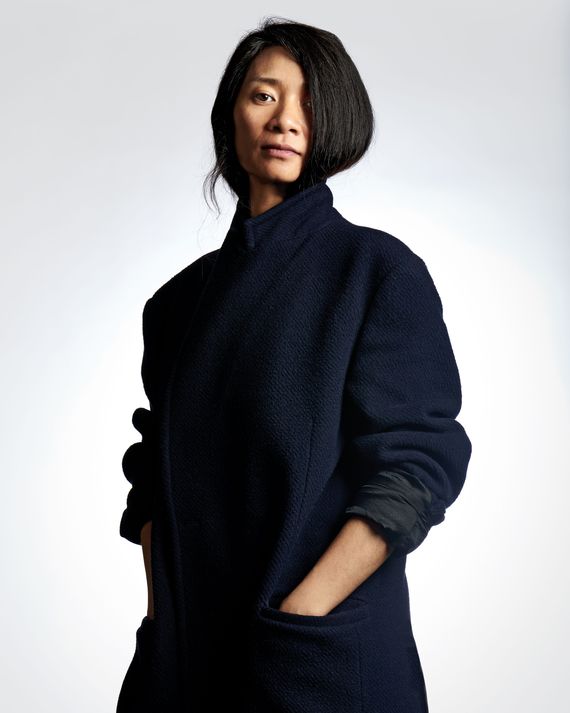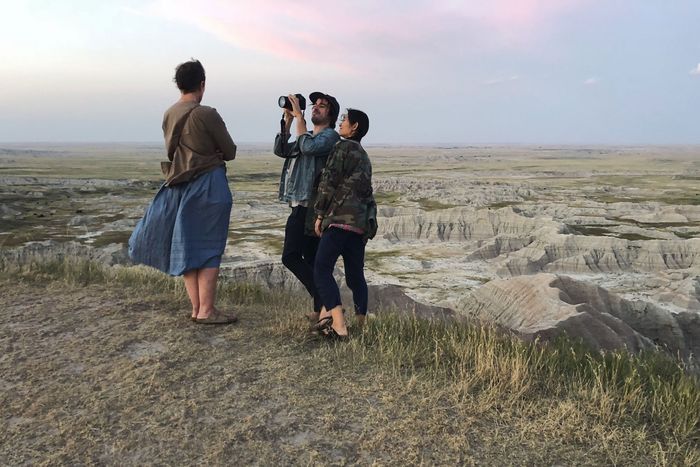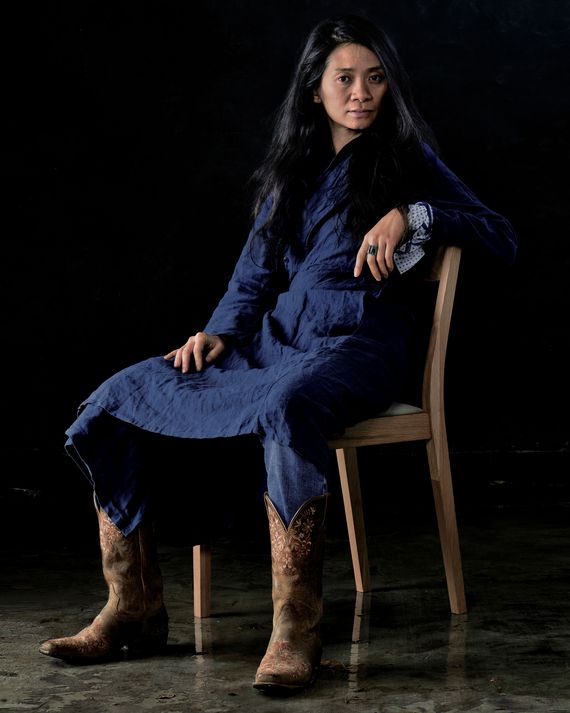
This article was featured in One Great Story, New York’s reading recommendation newsletter. Sign up here to get it nightly.
Chloé Zhao used to say she sometimes forgot she was Asian. It wasn’t something she meant as a statement of racial renunciation or a “We’re all citizens of the world” platitude. Zhao, the filmmaker behind the Oscar-favored Nomadland, is fully cognizant of the fact that she’s 38 and five-foot-six (and a half), with what she impishly describes as the typical traits of northerners in China: “Loud, obnoxious, big bones — I love stereotyping my own people.” What she was trying to articulate was a reflection of her own slippery sense of self, made more elusive by her years spent moving around the globe.
When she was growing up in Beijing in the 1980s and ’90s, being Chinese was simply the context in which she and everyone around her existed. A few border crossings and two decades later, she would find her way to the Pine Ridge Indian Reservation in South Dakota — where she would eventually make her generation’s best film about the American West. Zhao wasn’t the first artist to come from outside an Indigenous community with the intention of telling a story set within it. But she was coming from far outside it, so far that she felt unconstrained by both American colonialist history and the legacy of guilt that comes with it. Zhao tried to make herself porous, immersing herself in life there and attempting to get past the familiar narratives offered up to expectant visitors. She filled her films with locals, guiding them through fictionalized performances that were informed by their own experiences. She found John Reddy, the lead in her 2015 debut, Songs My Brothers Taught Me, in a school yearbook and cast him as Johnny, a teenager who dreams of getting away from the reservation. She met Lakota cowboy Brady Jandreau when he was working at a ranch and cast him in The Rider as Brady Blackburn, an injured rodeo star who struggles to find a sense of purpose after being told he can’t ride anymore. Out there in the Badlands, she recalls being the only Chinese person around, and it made her origins feel incidental to her. What was the utility of thinking of yourself as part of a group when there was no group — when it was just you? Can feeling as if you’re from nowhere be an advantage?
For Zhao’s career, it undoubtedly has been. Over the past four years, she has become one of the most pursued directors in Hollywood thanks to a trio of devoutly noncommercial features. By the time she started shooting Nomadland in the fall of 2018, she had attracted the attention of a major star, Frances McDormand, who co-produced the film and plays its heroine. Nomadland is by no means a standard Oscar movie, but this hasn’t been a remotely standard Oscar cycle. The film has managed to become a likely Best Picture nominee and the current favorite to win. And it may well be the defining movie of the past tumultuous, terrible year. It follows a loose collection of nomads for whom “retirement” means traveling the country for seasonal work after losing their savings in the 2008 recession or never having any to begin with. It’s an exploration of tattered safety nets, stubborn individualism, and economic decay in the heartland, as seen through the eyes of Fern (McDormand), who starts living out of her van after the death of both her husband and the community in which they made their home.
And now, Zhao is making a Marvel movie, which will dwarf her previous work by many measures, an installment of the franchise’s next phase that is crammed with milestones of representation. Eternals will boast the MCU’s first gay superhero and its first deaf one. It features a diverse cast that includes Kumail Nanjiani, Brian Tyree Henry, Salma Hayek, and Gemma Chan as well as Angelina Jolie and Richard Madden. The film was pushed back because of COVID, then pushed again, and Zhao is now in postproduction on a millennia-spanning blockbuster and making hour-and-a-half-long treks to Burbank while juggling the demands of a socially distanced awards campaign for Nomadland. Her career arc, from a microbudget drama set on a reservation to a saga about immortal aliens, may sound disorienting, but this is what success looks like for a modern director in Hollywood.
Chloé Zhao currently lives in Ojai, in the Topatopa Mountains outside Los Angeles, with her partner and cinematographer, Joshua James Richards, their two dogs, and some chickens in a house overlooking orange groves. It’s home, though that’s a concept that has always come with a lot of baggage. When doing research for Nomadland, Zhao found that some people who ended up on the road stayed there only until they could save up enough money to live in a fixed location again, while others discovered that the road was where they belonged. “I believe some people were just born to move. Others like to stay still,” she says. She understands both urges equally. “I’m a homebody. I’m the descendant of rice farmers. And sometimes, I want to run.”
Born Zhao Ting, she was a rebellious child and a poor student growing up. Her father rode the wave of China’s industrialization to great success, first as a top executive at one of the country’s largest steel companies, Shougang Group, and later in real-estate development and equity investment; her mother worked in a hospital. (They divorced, and when Zhao was in high school, her father married Song Dandan, a famous comic actress Zhao grew up watching on television.) Her parents largely let her be, and she sought out other things to relate to. She fell in love with manga and Michael Jackson and the movies of Wong Kar-wai — especially 1997’s unmoored Happy Together, in which Leslie Cheung and Tony Leung play lovers stranded in Buenos Aires. She still watches it before starting work on her own projects (“It’s like a ceremony,” she says). She jumped at a chance to go westward to boarding school in the U.K. at age 14, not yet speaking much English. It was the start of her life on the move.
In 2000, she came to Los Angeles to finish high school. That was the year she grew up, she says, attending a local public school and living alone in a studio apartment in Koreatown behind a Sizzler. “I had such a romanticized version of what America was.” Of her surroundings, she remembers thinking, “Well, this is not what I saw in the movies.” She wanted to learn more about the country than what had filtered through to her on screens, which is how she ended up majoring in political science at Mount Holyoke. Four years was enough to turn her off of politics; after a postcollege stint bartending and doing odd jobs, she found herself drawn more to people than to policy.
Filmmaking was a career Zhao sidled up to. She wanted to tell stories for a living but wasn’t great at painting, photography, music, or any of her other interests. “You don’t have to be a master of anything, just a jack-of-all-trades, to be a director,” she says. “I hire people who are really good at their craft, then put them together.” She enrolled in film school at NYU. Her classmates were what she describes as a lot of people experiencing quarter-life crises. A sample conversation she offers: “ ‘Why did you go to film school?’ ‘I went to a liberal-arts college, and I don’t know what to do with my life.’ We had a lot in common.” She had Spike Lee as a professor, whom she could always count on to be hilariously and brutally honest. NYU is also where she met Richards, a student from Cornwall, England. The two started up a romantic and creative partnership, and he would go on to shoot her first three films. “She was gnarly and extreme — my idea of the collaborator I hoped to find at film school,” Richards says. “Most people I was spending time with were sitting around talking about their projects. Chloé was doing them. And so I jumped on that train.”
Zhao loved the city, but the difficulty of securing locations to shoot in was stifling. “I can’t make it there,” she found herself realizing. “I don’t think I can make good enough films in New York.” For her second-year film, she flew back to China to do what she describes with an eye roll as “a lot of imitating Zhang Yimou’s Raise the Red Lantern.” She has no intention of letting the resulting short see the light of day, yet it crystallized something about what would become her sensibility: “It’s the first time I worked with nonprofessional actors. I went out there and found a young girl who was in a dance school.” The point of the assignment had been to work with actors, but Zhao discovered she preferred to build a film around someone who was already in a place she wanted, focusing instead on the world she was putting onscreen. “I realized,” she says, “I’m not the kind of writer-director that can create this character on my own in a dark room.”
Zhao had only a textbook understanding of Native American history when she started eyeing the Dakotas in her final year of film school. For her thesis, she was working on a script set in Devils Lake, North Dakota, for no reason other than she liked the plains and the name of the place. In the course of doing that research, she came across photojournalist Aaron Huey’s vivid pictures from the Pine Ridge Indian Reservation across the border in South Dakota. She was struck by the images and filled with curiosity and a feeling that, as she puts it, “maybe I could tell a story to make things better.” She’s not the first artist to have been driven by some combination of good intentions and ego, nor the first filmmaker born into privilege to have been drawn to characters living in poverty. It’s a feeling she now describes as a trap.
The Oglala Lakota reservation of Pine Ridge is one of the largest in the U.S. and contains some of the country’s poorest counties. Journalists and artists had been making the trip there for long enough that the residents were adept, Zhao quickly discovered, at telling her what they thought she wanted to hear — stories of poverty, alcoholism, historical trauma. “It took me a good six months to a year to get past that. If I had just dipped in and out, I would never have,” she says. She still had a place in New York but was spending long stretches in South Dakota getting to know people. “Let’s talk about what you have for dinner,” she would say. “What did you really have for dinner? What do you want me to say you have for dinner?”
Stick around long enough, she found, and people have no choice but to be rude and real. She subbed for the teacher of a creative-writing class at a local high school, and the students wrote about wanting to work on everything from animation to horror movies. When the time came to apply for indie filmmaking grants, though, they invariably turned toward stories of struggle. “I was like, ‘What happened to the zombie apocalypse?’ ”
It was frustrating to her. “That’s not progress, to have to tell a certain kind of story to fit into this film festival.” Yet that’s often what’s required when you’re making a pitch for relevance to cultural institutions. Zhao ended up going through a not-dissimilar circuit of labs and grants in an effort to fund what she hoped would be her first film, a Pine Ridge–set feature titled Lee. She planned to use nonactors from the area and to work from a traditional script. It was a plotty narrative about a boy trying to decide whether to leave the reservation. She wrote 30 drafts, adjusting the story each time to accommodate the budget. After three years, Zhao and Richards were on the verge of shooting the film when the funding fell through. They were at a camera test in New Jersey when they got the news, and when they drove back to their apartment in Bushwick, they found it had been broken into. Everything, including laptops and hard drives with footage they had already shot, was gone.
It was devastating yet also liberating. “I got ahead of myself,” Zhao admits. “I thought that movie was my identity. When it was taken away, I actually found myself because I would have not made it right that way.” Making it right meant taking the $70,000 they had in the bank, raising $30,000 more, and heading out to Pine Ridge with a minimal crew and the intention to do something nimbler and more organic. The resulting film, Songs My Brothers Taught Me, is about a teenager named Johnny Winters (John Reddy) who’s considering following his girlfriend, Aurelia (Taysha Fuller), out to L.A. when she leaves for college. He doesn’t have solid plans for what he would do there, but he feels restless and prospectless on the reservation. At the same time, he’s aware that he would be abandoning his 11-year-old sister, Jashaun (Jashaun St. John), to live alone with their alcoholic mother, Lisa (Irene Bedard). Although the film isn’t devoid of the elements Zhao had seen prioritized in so much art about Pine Ridge, it is focused on an idea she wanted to explore in the first place — home, and whether to stay or go.
Every morning, Zhao wrote the scenes they were going to shoot that day, incorporating material from events in the area and the actors’ lives. When St. John’s childhood home burned down, she and her family agreed to let the incident be incorporated into the film. The story line is partly fictionalized, though the anguish St. John expresses as she digs through the ashes searching for anything left is real. These negotiations required a superhuman level of trust. “Honestly, when I met Chloé, I thought she had some Native in her,” says Fuller, one of the cast members who came from an acting background. “She was very in tune. It was like one of our own.” They also required Zhao to determine where vulnerability gives way to possible exploitation. What she requires of her performers is something she has grown more confident about over the course of her three films. “I have asked a lot,” she admits.
Nonprofessionals, untrained actors, real people — there’s no ideal term for the tradition Zhao is part of, which stretches from Sergei Eisenstein, Robert Bresson, and Italian neorealism to The Florida Project’s Sean Baker, who started using the term first-timer after finding that nonprofessional tended to make people in the industry write performers off. And isn’t someone who gets paid to act in a movie a “professional” by definition? Haven’t scores of stars risen to fame without formal training? The idea in casting people who aren’t actors by profession or aspiration is to get away from the artifice that’s inherent in traditional filmmaking — but that tends to sell short how much art and effort is involved.
Songs My Brothers Taught Me went to Sundance and Cannes. Zhao brought Reddy and St. John with her to the south of France and arranged for the cast members to get a share of any profits the movie generated. The film didn’t make enough money for that to come to pass, but it was something she did for The Rider and Nomadland as well. “Most nonprofessional actors aren’t going to go on to be actors. Their career isn’t going to be benefiting from this,” she says. “You sleep better if you give them support that way.”
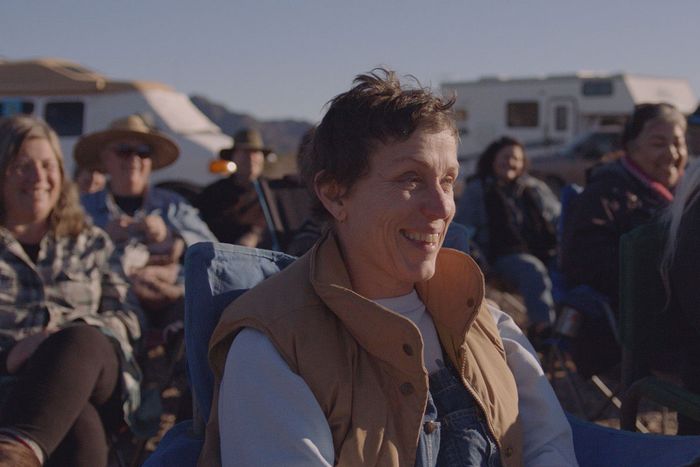
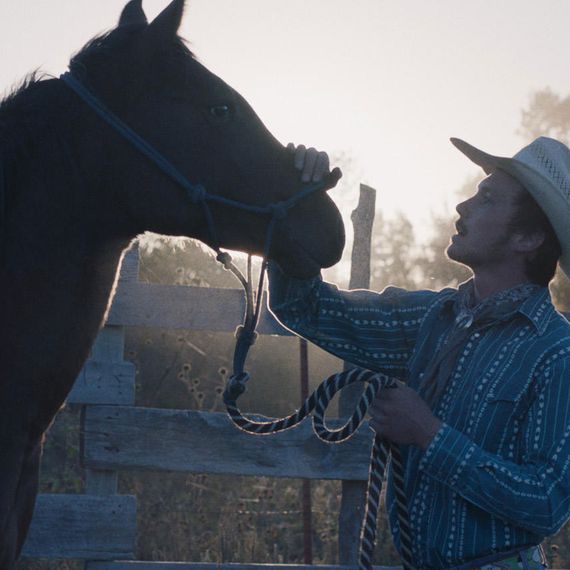
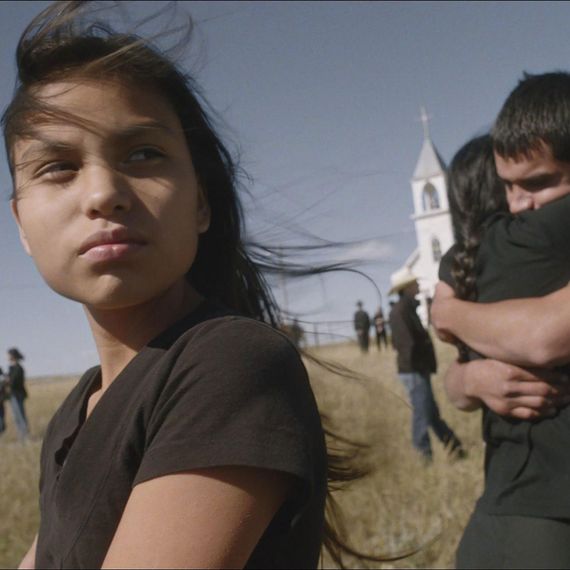
Zhao’s second feature, 2017’s The Rider, was self-financed and made on an even tighter budget, with a smaller crew, than her debut. While Songs trickles through different parts of Pine Ridge like a splitting stream, The Rider keeps a tight focus on its protagonist, Brady Blackburn. She met the film’s star, Brady Jandreau, a Lakota horse trainer and rodeo competitor, while she was in South Dakota scouting her next projects. He had an intensity and camera readiness that reminded her of Heath Ledger. She wanted to build a movie around him but couldn’t figure out what it would be.
Then, in April 2016, Jandreau took a blow to the head from a bronco at a rodeo that put him in a coma for five and a half days. He was told by doctors that riding again could irreversibly damage his brain; a few months later, he was back on a horse anyway. When Zhao witnessed that, The Rider was born. The film is at once about the iconography of the cowboy and a person who is infinitely more complicated than his own self-conception. Brady feels an obligation to demonstrate his machismo, but the movie itself is astonishingly tender — with him; with his family, played by Jandreau’s sister and father; with his best friend, Lane Scott, who plays himself; and with the horses Brady works with in long heart-stopping stretches.
The Rider had no trouble getting traction from the start. Sony Pictures Classics picked it up for distribution at Cannes. It played a trifecta of prestigious festivals — Telluride, Toronto, New York — earning rapturous reviews from critics and accruing prominent fans, including Bong Joon Ho, who put Zhao on a list of emerging directors he believed would shape the next 20 years, and Barack Obama, who put the film on his annual list of favorite movies. Another of those fans was McDormand, who sneaked out to see it at TIFF between press obligations for Three Billboards Outside Ebbing, Missouri. She wasn’t just transported; she felt the movie had an enveloping quality that spoke to something she prized in her own career. “One of the major reasons I don’t do a lot of publicity or sell perfume or watches,” she explains, “is because I want to be able to serve a story and audience so they can go into that room like I did with The Rider and, within the first couple of frames, be lost in a world they’ve never experienced before.”
McDormand wanted to meet with Zhao, though she wasn’t sure what would come of it. As it turned out, McDormand, who describes her producing career as “nascent,” had picked up the rights to Jessica Bruder’s Nomadland: Surviving America in the Twenty-First Century, a nonfiction book about older Americans who travel the country for work. Zhao had been writing a similar project of her own, though hers was about young van lifers (“Terrible script — it wasn’t working,” she says). The reasons an older generation would opt for a pared-down life on the move fascinated the director: “It felt like fate. I didn’t feel like I was jumping to something else, but a deeper version of what I wanted to do.” Together, the women made a hybrid — a film centered on a delicate performance from McDormand as Fern, a widow who takes to the road when her community becomes a ghost town after the closure of the nearby gypsum mine. McDormand’s turn is embedded in a world of real nomads playing themselves. Among them are Bob Wells, the movement’s YouTube evangelist; Swankie, who offers lessons in self-sufficiency to Fern; and the ebullient Linda May, who tells a story about contemplating ending her life. (While an Oscar nomination for McDormand is all but guaranteed, Searchlight has campaigned for all three of those nonprofessional actors, some of whom have an understandable tendency to go off the grid rather than accommodate any press clamor.)
The wide-open landscapes of Arizona, California, Nebraska, Nevada, and South Dakota have perhaps never looked as breathtaking as they do in Nomadland. The film also makes its way into the sprawling industrial interiors of an Amazon warehouse. The company’s Camper-Force program is a tentpole of nomad life, created to reach out to the community with offers of seasonal work and RV-parking spaces. McDormand called Amazon to see if they could shoot inside one of its warehouses, and they were allowed liberal access. Given the corporation’s notorious labor issues, it’s a shock when the cameras follow Fern into the building. McDormand chalks up this development to a recent change that had netted Amazon some relative goodwill: “Right before we started filming, they raised the hourly rate to $15. They had something to be proud of; we were on that rush of great feeling.” While Nomadland isn’t exactly sunny about the spectacle of 60-somethings engaged in the grueling physical labor of picking and packing, what it depicts can’t really be called a takedown of the corporation, either. Fern, like a lot of the real CamperForce, is happy to have the work. It is, she says, “good money.”
That restraint when it comes to editorializing — along with the impression, because of where her films are set, that Zhao is a chronicler of Trump country (“Unfortunate,” Zhao says of the label) — has led some viewers to call Nomadland apolitical. Zhao finds this baffling. Wells, for instance, gives a spiel during the film about how he sees nomadism as a lifeboat for an existence that’s sinking like the Titanic. Zhao calls it “the most socialist speech I’ve ever heard — and I’m from China.” And May’s suicidal feelings stemmed from her desperation about having nothing in her 70s after working her entire life. Amazon, Zhao believes, is an easier villain than the structural issues that enable CamperForce to exist, which is why she filmed the warehouse scenes the same way she did the scenes of Fern cleaning toilets on a campground and shoveling beets in Scottsbluff, Nebraska. “If you look deeply, the issue of elder care as a casualty of capitalism is on every frame,” she says. “It’s just, yes, there’s the beautiful sunset behind it.”
Zhao’s films sometimes get slapped with the term docudrama, but that implies a fidelity to actual events, which her works aren’t bound by. They aim not for the on-the-fly feel of nonfiction but the grandeur of the Western, the genre to which they really belong. They juxtapose lyricism and realism, making use of magic-hour light in a way that has netted Zhao comparisons to Terrence Malick. They also demonstrate an endless appreciation for the vastness of American landscapes. Toward its close, Nomadland quotes one of the most famous shots in film history from John Ford’s The Searchers. Fern may not have much in common with Ethan Edwards, the embittered Civil War veteran played by John Wayne, but the framing places them side by side as peers in frontier rootlessness, striding off toward the broad horizon.
It’s not unusual these days for an indie filmmaker to make the jump into a costly franchise. Barry Jenkins is doing a sequel to The Lion King; Captain Marvel was directed by Anna Boden and Ryan Fleck, the team behind Half Nelson. There just aren’t many medium-size pictures to grow into anymore. Zhao recalls getting out of film school and being asked only for elevated horror: “Is there a ghost, maybe, in your family?”
Hollywood’s hunger for new talent outside the regular roster of white males means young directors don’t always need a calling-card commercial project to get attention from executives anymore. Establishing yourself as a masterful artist concerned with authenticity and regional texture isn’t necessarily an impediment to moving on to blockbusters. Zhao’s career is a prime example of what is asked of the contemporary Hollywood director: to be able to handle both the exquisitely intimate and the massively corporate. For the past few years, she has been working on a biopic of Bass Reeves, one of the first Black deputy U.S. Marshals in the West; in early February, it was announced that she will be directing a futuristic sci-fi–Western take on Dracula for Universal.
Directors may be slotted into these projects, but the question of how much of a stamp they can put on the material remains open. In 2018, the Argentine filmmaker Lucrecia Martel told the attendees of a Mumbai Film Festival master class about her experience being considered to direct Black Widow (a job for which Zhao was in contention at one point). “What they told me in the meeting was, ‘We need a female director because we need someone who is mostly concerned with the development of Scarlett Johansson’s character,’ ” she said. “They also told me, ‘Don’t worry about the action scenes. We will take care of that.’ I was thinking, Well, I would love to meet Scarlett Johansson, but also I would love to make the action sequences.”
While the Marvel Cinematic Universe may be a giant multi-platform enterprise that’s currently ruling popular culture, it also needs voices like Zhao’s. As it continues expanding into streaming, the movies have started to introduce characters that are less familiar to audiences with only a passing knowledge of comics. Eternals, based on Jack Kirby creations from the ’70s, constitutes a much deeper cut than, say, Spider-Man. The new era of the MCU on the big screen would seem to demand directors with a vision for characters who can’t depend on name recognition. Zhao may now be working with a cast made up largely of professionals, but she has found that interesting things happen when you pry actors out of their protective coating of celebrity glamour. Her approach to directing them hasn’t changed that much. Kumail Nanjiani recalls meeting with Zhao about his character, an Eternal living as a Bollywood star. “I was like, ‘Okay, so how do you see Kingo?’ She was like, ‘He’s you. I picked you because I wanted him to be you.’ That’s how she picked the entire cast. She wanted everybody to put pieces of themselves into their characters.”
The MCU is also, slowly, trying to add more diversity to its roster both in front of and behind the camera. Eternals is a vehicle for a lot of that advancement. Nanjiani recalls looking at a shot of the ensemble and tearing up: “You never see a movie with a cast that looks like the world this much, let alone big superheroes in a Marvel movie.” Zhao, who once protested to fellow filmmaker James Ponsoldt in an interview that she had no interest in being “your token Asian female minority director” (“Too late for that!” she now jokes), has been anointed with the title of first Asian woman to direct an installment of the franchise. She is aware of the irony of having made films dedicated to exploring the inadequacy of labels only to now be working on something that can’t yet be talked about beyond these vague triumphs. For all those firsts, Eternals may more fittingly be described as international than diverse, anyway, given the global audience required for the modern blockbuster.
Lately, Zhao has felt her body overruling a lifetime of placelessness with persistent indications of where she’s from — like the loss of her ability to tolerate the pizza she used to down easily or a reemerging preference for drinking hot water instead of the U.S.-standard cold. It’s as though, she says, her appetites have decided to weigh in on the questions that have shaped her not-quite-decade-long career — who are you? Where do you belong? — with a straightforward ruling of rice and bok choy. “I think it does call you,” she says. “The older people get, the more they get called home.” But this is the thing about embracing rootlessness: It can speak to a sort of privilege, the ability to move on, or elsewhere, to go somewhere new and anticipate that you’ll be accepted, and to return home if you feel called.
When Zhao returned to Pine Ridge to film The Rider, many in the community welcomed her back, but not everyone agreed that her efforts to depict the area more authentically in her debut were so different from those of the filmmakers who had come before her. “It felt like, Oh, here we go again,” Willi White, an Oglala Lakota filmmaker and community organizer who lives on the reservation, recalls thinking when he watched Songs My Brothers Taught Me. “It fell into those tropes a lot of us have started our careers around, which was taking back our narratives — playing into the poverty porn.”
That remains the impossible battle at the heart of representation: wanting to acknowledge the wounds that exist and to draw attention to neglect and oppression while trying not to be reduced to those things onscreen, to escape from the expectations of miserablism. Zhao has been thinking a little differently about her place outside American consciousness and the pains of its history. “I should take those things into consideration because they are deeply rooted in the psyches of people who grew up here, not in mine,” she says. “In the end, we leave, but their lives continue.”
*This article appears in the February 15, 2021, issue of New York Magazine. Subscribe Now!



